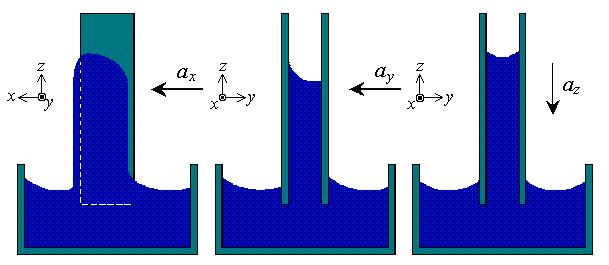capillary rise with residual accelerations
The capillary flow in geometries of open cross section (e.g. parallel plates) under the influence of variable residual acceleration is studied. For simplification the residual acceleration is produced in certain directions and the reaction of the liquid is observed. Fig. 1 shows three cases how the acceleration can affect the capillary flow between parallel plates.

Due to the disturbing acceleration the shape of the climbing meniscus can be changed in the way sketched in Fig. 1. The change of the meniscus shape affects the capillary force and thus the flow velocity of the liquid. The free surfaces at the sides of the vane will deviate from their original shape, too. This effect can influence the liquid rise as well. In case of higher values of acceleration liquid can be pushed out of the vane. The liquid column could break up and capillary fluid transport becomes impossible.
The residual acceleration is produced artificially by a centrifuge that is mounted inside the capsule. Accelerations that are constant or variable in time can be generated. The fluid motion is recorded by video. The liquid height and the shape of the meniscii are determined after the drop.
In the third part several phenomena of the capillary rise are studied. Flow patterns below the meniscus and at the entrance of the vane are observed by means of flow visualization using light sheet technique and tracer particles. Some details of the theoretical model may be improved in this way.
The aim of this project is to model the capillary rise in closed and open geometries under variable residual acceleration to get reliable predictions for the fluid behaviour in capillary vanes. The theoretical results are verified by appropriate experiments in the drop tower “Bremen“.
The figure below shows a single frame of a drop tower experiment video. Two plates of same breadth (40 mm) are mounted parallel to each other at a distance of 8 mm. The test liquid is Dow Corning Silicone Fluid. A measure is attached to the front plate for the evaluation of liquid height. The video camera is turned about 90°. The lateral acceleration ax = 0,16 m/s2 is acting downwards.
Click on the figure to see the video (101 kB) of this experiment.
The research support of this project by the German Aerospace Center DLR under grant number 50 WM 9443 is gratefully acknowledged.



 "
"